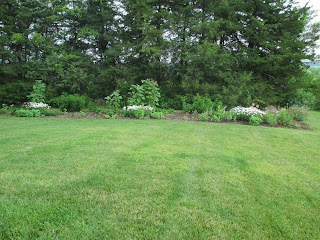The North Border
In 2009, my husband tilled up two strips from the yard behind our house in which to plant vegetables, one on the north side of our yard and one on the east. We planted vegetables in both beds that first year, but in 2010, I expanded my rose cutting garden in the north border, and left one end for our daughter Lily's annual flower garden. The east border (now named the Peony Border) was still used for vegetables, along with the larger garden at the top of our field (now named the Kitchen Garden). |
| My rose cutting garden, in what is now the North Border. |
I continued to add more roses in the North Border until I had more than 50, mostly hybrid tea roses in numerous colors for cutting. They were very beautiful during early June and again in September....
 |
| I love cut roses, especially ones that smell heavenly. |
...but not so beautiful the rest of the time. Months without bloom, leggy canes, Japanese beetle-stripped leaves. This is not what I wanted to look out at from my kitchen window (as shown above). So I decided that a change was in order.
I made plans all last winter for the flowery mixed border I would have: bulbs in spring, perennials in early summer, annuals and a few more perennials in late summer and into fall. I thought I would get an early start transforming the border by moving the 50+ roses in April -- but the weather was horrible, plus I had to stay off my leg because of the stupid stress fracture. So at the end of April, I paid a college student to transfer all the roses to the east Peony Border.
Then my husband rented a mechanized sod cutter to remove the grass from the area on the west end of the border, to make the border longer -- about 60 feet long -- and he tilled up the new area. In early May, I was able to put three truck loads of compost from the local landfill on the border, both to improve the soil and to suppress weeds, and then it was ready to plant!
 |
| A blank slate, 60' long by 12' deep |
In mid-May, I planted the border: 3 peonies (one of which I believe might have succumbed to the drought), shasta and ox-eye daisies, phlox, perennial helianthus, dame's rocket, daylilies, iris, oriental lilies and Asiatic lilies. Annuals included zinnias, cosmos, four o'clocks, snapdragons, sunflowers, cleome and nasturtiums. I also planted hollyhocks (which survived) and foxgloves (which did not). In fall, I planted bulbs: 600 Darwin hybrid tulips, 360 mixed daffodils, 100 'Purple Sensation' alliums, 6 white eremurus (foxtail lilies) and 10 crown imperial fritillaria.
The border is planted in 2-3 repeating groups, with tall perennials and sunflowers in back, mid-height perennials and most of the bulbs in the middle and the front reserved for annuals. Because the border will mostly be viewed from inside the house at some distance, I have tried to plant larger groups of five or more perennials, as well as large-flowered plants such a sunflowers. Additionally, because of the dark background of the cedar trees in the north windbreak, I mostly grow light- or bright-colored flowers, staying away from darker tones, particularly dark reds and blues, as much as possible.
 |
| Year 1 in the North Border. Still sparse, but I have high hopes for its floriferousness. |
Thank you for your visit and comment. I see you like roses too and from this post it looks like you have a lot of garden work to do.
ReplyDeleteThanks for visiting too, Barbara. Yes, I do love roses (although mine aren't as lovely as your English roses!) and I do have a lot of work -- and I keep making more work for myself.... Best Regards, Beth
Delete